博文
[Science]胚与胚乳之间的分子双向交流在种子发育过程中必不可少(2)
|||
A two-way molecular dialogue between embryo and endosperm is required for seed development
Author: N. M. Doll, S. Royek, S. Fujita, et al.
Corresponding author: G. Ingram.
Affiliations: Laboratoire Reproduction et Développement des Plantes, University of Lyon, ENS de Lyon, UCB Lyon 1, CNRS, INRAE, F-69342, Lyon, France, et al.
[CONTINUED]
We tested whether TWS1 is a substrate of
ALE1 by coexpression of ALE1:(His)6 and
TWS1:GFP-(His)6 fusion proteins in tobacco
(Nicotiana benthamiana) leaves. A specific
TWS1 cleavage product was observed upon coexpression of ALE1 but not in the empty-vector
control, suggesting that TWS1 is processed by
ALE1 in planta (Fig. 1P).
为了探究TWS1是否是ALE1的作用底物,我们在烟草叶片中创建了ALE1:(His)6/TWS1:GFP-(His)6的共表达载体。我们在共表达体系中检测到非常特别的TWS1分裂产物,但在对照组中没有。这表明TWS1在植株中会被ALE1加工。见下图。
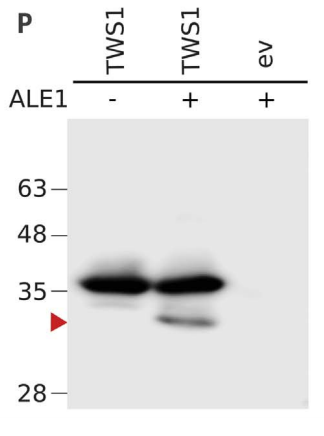
Likewise, recombinant TWS1 expressed as GST-fusion in Escherichia coli was cleaved by purified ALE1 in vitro. (Fig. 1Q).
同时,在体外实验中,在大肠杆菌中表达TWS1的GST融合蛋白,发现TWS1同样会被纯化的ALE1蛋白分解。见下图。

Mass spectroscopy analysis of the TWS1 cleavage product purified from tobacco leaves showed that ALE1 cleaves TWS1 between His54 and Gly55 (fig. S6).
对烟草叶片中TWS1分解产物的质谱分析结果显示,ALE1在His54(54号组氨酸)和Gly55(55号甘氨酸)之间的区域将TWS1分解。见下图。

These residues are important for cleavage site selection, as ALE1-dependent processing was not observed when either His54 or Gly55 was substituted by site-directed mutagenesis (Fig. 1Q). His54 corresponds to the C-terminal His or Asn of CIF peptides (Fig. 1O). Thus, the data suggest that ALE1-mediated processing of the TWS1 precursor marks the C terminus of the TWS1 peptide. Because the CIF1 and CIF2 peptides are located at the very end of their respective precursors, C-terminal processing could represent a mechanism of peptide activation operating in the developing seed but not in the root. A summary of TWS1 modifications is provided in Fig. 1R.
这些残基对于TWS1分解位点的选择非常重要,因为这个依赖于ALE1的分解过程中并没有观察到定点诱变引起的氨基酸替代之后分解位点的改变,见前面电泳图。前文提到过,His54与CIF1多肽的组氨酸或天冬酰胺的羧基端相连。因此,这些数据可以揭示,由ALE1所介导的TWS1作为底物的分解进程标记在TWS1多肽的羧基端。因为CIF1与CIF2多肽定位于它们各自前体非常末端的位置,羧基端的处理可以代表一种多肽活化工作机制,这种机制存在于发育中的种子中而非根中。对于TWS1的蛋白修饰功能的总结见下图。

To test the biological activity of TWS1, the predicted peptide encompassing the conserved N-terminal DY motif and the C terminus defined by the ALE1 cleavage site was custom-synthesized in tyrosine-sulfated form. As synthetic TWS1 cannot easily be applied to developing embryos, a root bioassay for CIF activity was used. In wild-type roots, TWS1 induced ectopic endodermal lignification, as previously observed for the CIF1 and CIF2 peptides (12). TWS1 activity was GSO1-dependent, suggesting that processed TWS1 peptide can replace CIF1 and CIF2 as a ligand for GSO1 during Casparian strip formation (Fig. 2A and fig. S7).
为了探究TWS1的生物功能,我们定制(custom-synthesized)了一个包含保守氨基端的DY基序以及被ALE1分解位点所界定的羧基端的酪氨酸硫酸化式的TWS1多肽。由于定制的TWS1在发育中的胚胎中表达并不容易,我们就使用了曾经用于检测CIF活性的根部活体检测。在野生型根中,TWS1促进了异位内胚层的木质化(ectopic endodermal lignification),和曾经对CIF1/2多肽的检测观察结果一模一样。TWS1活动是依赖于GSO的,这表明被加工过的TWS1多肽可以替代CIF1/2来作为GSO1的配体参与凯氏带的形成。见下图。紫色为染色后的木质素,绿色为染色后的凯氏带(GFP荧光)。
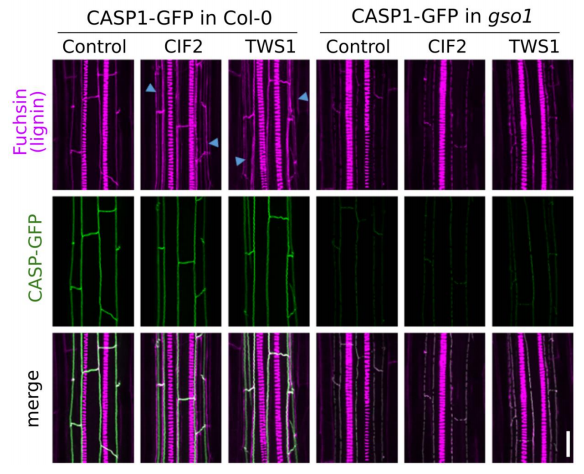
Supporting this, TWS1 application complemented the cif1 cif2 mutant, albeit with reduced activity compared with CIF2 (Fig. 2B and fig. S8). TWS1 activity in this assay was reduced when sulfation on the DY motif was missing (Fig. 2B).
为了验证这个想法,TWS1补充了cif1/cif2突变体的功能,尽管与CIF2相比活性稍差一些。另外,当不再有DY基序上的硫酸化过程时,TWS1的活性会下降。见下图。可以看到的是,在cif1/cif2的突变体中,凯氏带完整性降低,在用CIF处理之后完整性显著提升,TWS1处理后也有显著提升但比CIF处理稍弱,而未硫酸化的TWS1处理后没有显著提升。
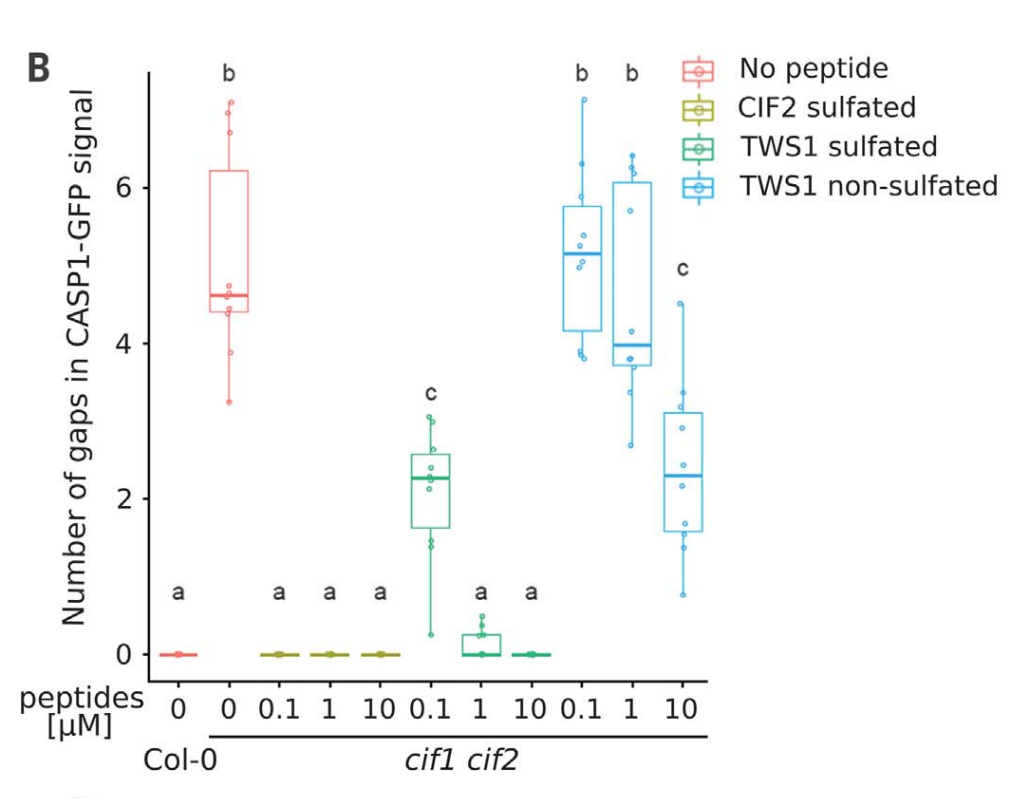
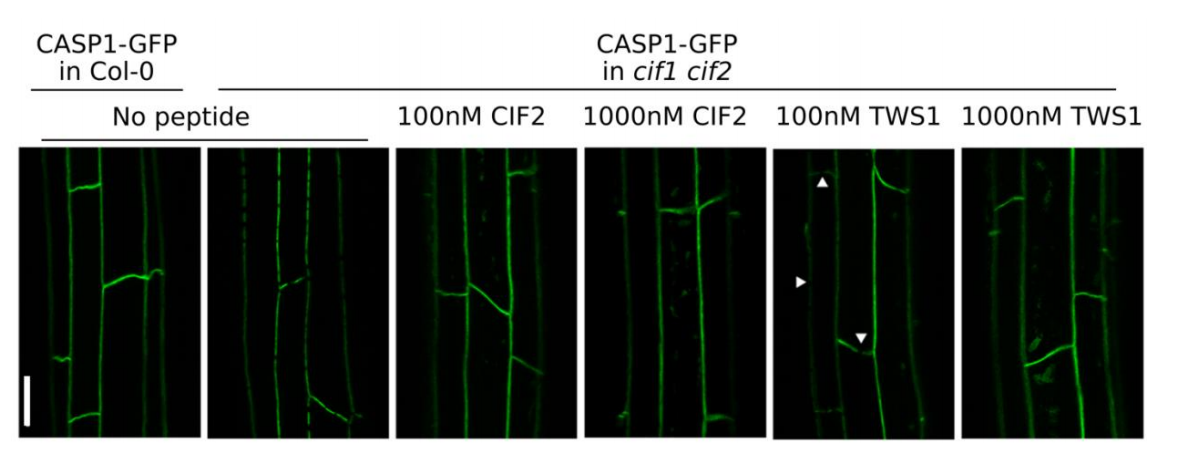
Versions of TWS1 in which Y33 was mutated to either F or T only partially complemented the mutant phenotype of tws1-4 (fig S9), consistent with a residual but weak activity for nonsulfated TWS1 in vivo and with the weak loss-of-function phenotype of the tpst-1 mutant.
将TWS1的Y(33)替换为F或T后仅仅部分补充了tws1-4突变体的表型,结果如下图。这与体内未硫酸化的TWS1表现出的弱活性的结论一致,也与tpst-1突变体的功能缺失表型一致。
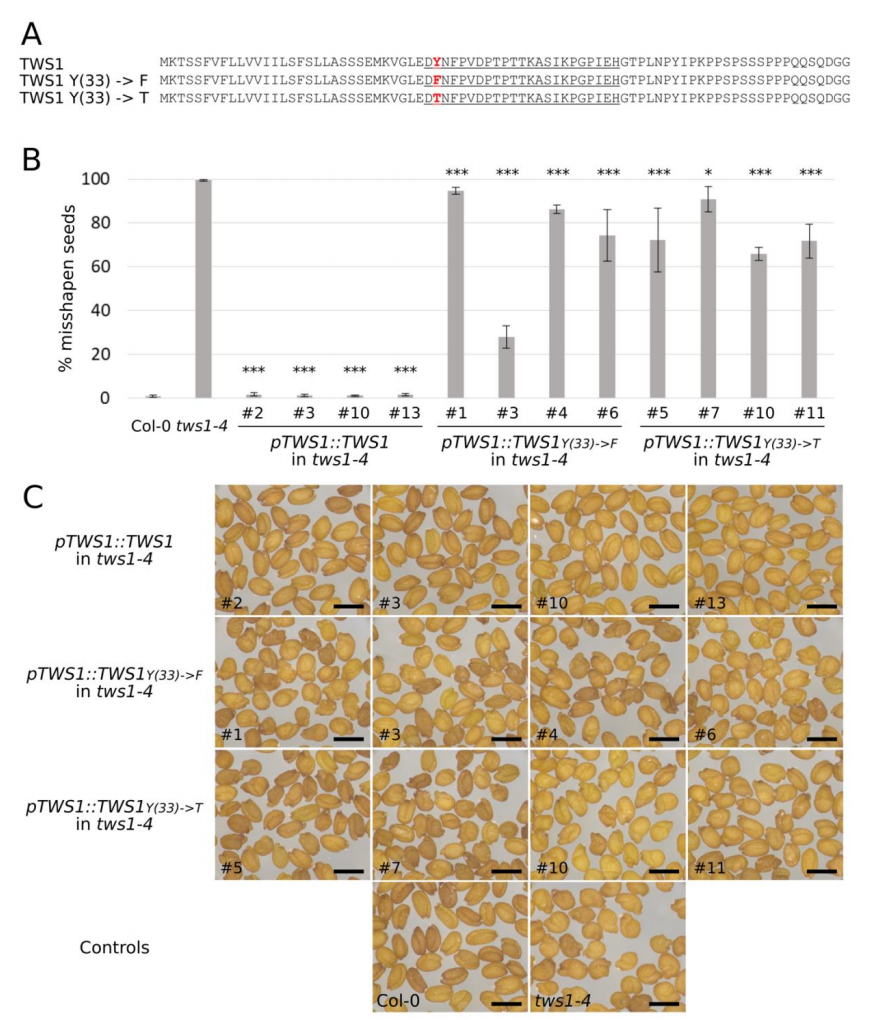
To confirm TWS1 as a ligand of GSO1 and GSO2, the interaction of the synthetic peptide with the leucine-rich repeat (LRR) ectodomains of the receptors was analyzed in grating-coupled interferometry binding assays. GSO1 bound sulfated TWS1 with a KD (dissociation constant) of ~30 nM (Fig. 2C).
为了验证TWS1是GSO1/2的配体,我们利用光栅耦合干涉结合分析实验(grating-coupled interferometry binding assays)分析了受体上的富亮氨酸重复序列(Leucine-rich repeat, LRR)胞外域与定制合成的TWS1蛋白的互作。下图是GSO1与硫酸化后的TWS1蛋白的互作分析,KD(dissociation constant分离常数, D)为30nM。红线为原始数据,黑线为拟合(fit)数据。
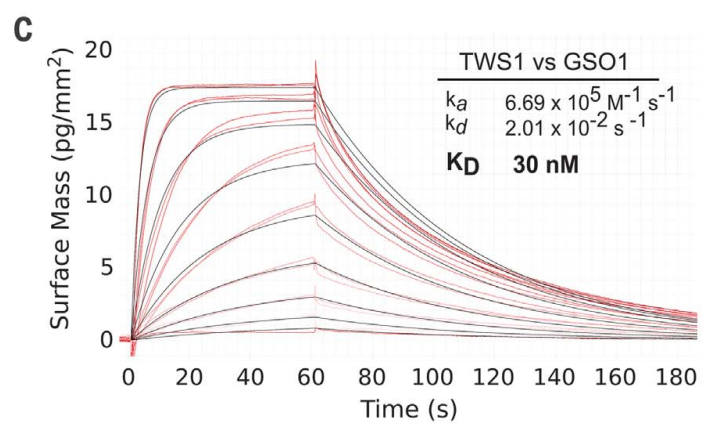
The observed binding affinity is ~1/10 that of the CIF2 peptide (KD = 2.5 nM) (fig. S10), which is consistent with the reduced ability of TWS1 to complement the root phenotype of the cif1 cif2 double mutant (Fig. 2B).
而GSO1与CIF2的KD则只有1/10,大约2.5nM,见下图。这与之前实验中,TWS1只能补充部分cif1/2双突突变体的表型结果是一致的。

Sulfated TWS1 also bound to the LRR domain of GSO2, albeit with slightly reduced affinity (KD ~ 100 nM) (Fig. 2D).
TWS1与GSO2的LRR区域也是存在互作的,但是关联性稍低,KD大约在100nM。

As previously shown for other CIF peptides (11), tyrosine sulfation was critical for the interaction of TWS1 with GSO1 and GSO2 in vitro (Fig. 2, E and F).
酪氨酸的硫酸化对于TWS1与GSO的体外互作是非常重要的。如下图分别为GSO1/2与未硫酸化的TWS1的互作结果。

Technical issues at high peptide concentrations may explain discrepancies between in
vitro binding assays and the in vivo activity
of nonsulfated TWS1. In vivo activities for nonsulfated versions of other normally sulfated
peptides, including CIF2, have been reported
(11, 16–18). Adding a 3AA C-terminal extension
to the sulfated TWS1 peptide reduced binding
affinity to both GSO1 and GSO2 (fig. S10),
consistent with the need for ALE1-mediated
C-terminal processing for efficient signaling.
过高的多肽浓度的技术问题可能可以解释,未硫酸化的TWS1在体外结合实验与体内活性实验的结果的差异。对于其它的硫酸化多肽在未硫酸化时的体内活性的实验结果,包括CIF2,已经有诸多报道了。我们在对硫酸化的TWS1的羧基端做了3AA延伸处理后,发现这降低了TWS1与GSO的结合紧密度,见下图。这与之前ALE1介导的羧基端加工过程对于信号通路非常重要的结论相一致。
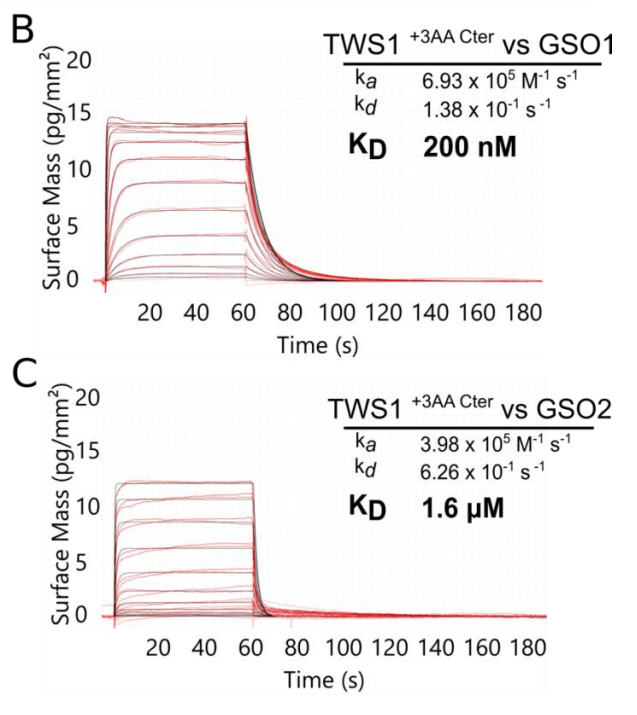
Taken together, our results suggest the sulfated TWS peptide as the missing link in the intercompartmental signaling pathway for embryonic cuticle formation. The activities of ALE1 and TPST both contribute to the formation of the bioactive peptide (Fig. 1R), which is perceived by GSO1 and GSO2 to ensure appropriate cuticle deposition.
总而言之,我们的实验结果证明,在胚胎表皮形成过程中的不同组分间构建起来的信号通路中,硫酸化的TWS多肽是一直没有被发现的重要的一环。而且,ALE1以及TPST都会参与激活TWS的生物活性,也正是这样才能让GSO1/2能够接收信号从而保证表皮沉积的正确性。
[TO BE CONTINUED]
附件是supplementary materials,供大家交流学习~
https://blog.sciencenet.cn/blog-3449010-1255065.html
上一篇:[Science]胚与胚乳之间的分子双向交流在种子发育过程中必不可少(1)
下一篇:[Science]胚与胚乳之间的分子双向交流在种子发育过程中必不可少(3/END)